A recently released set of data shows adolescent girls in rural Bengal setting a nationwide trend with their keenness to go to school. Comapred to their male counterparts, the central survey shows, rural girl students have a better attendance record.
The NSSO survey , carried out in January-June 2014, shows that in the gross attendance ratio and net attendance ratios in primary , upper primary and secondary classes, girls have overtaken boys by a good measure in rural Bengal. The results came in three months after the West Bengal Government’s launched its Kanyashree scheme -a conditional cash transfer or CCT to stop adolescent dropouts among girl students.
State women and child development minister Dr Shashi Panja said, “When Kanyashree was launched by the Chief Minister in October 1, 2013, it was followed by a sustained media campaign. This, we felt, had touched the common psyche. Otherwise, the number of beneficiaries would not have reached 2.5 million. In addition, we always had a Sabala project, in which, through ICDS centers in six districts, we try to spread awareness about dropping out from school. This is a welcome development.“
The minister’s statements on the impact of government schemes are not without reason. A bulk of the education infrastructure is still provided by the government, with private players lagging significantly .The NSSO survey indicates that for every 1,000 primary, upper primary, secondary and graduate schools, the government sponsors 927 while only 26 are private-aided.
What makes this attendance data significant is the amount of effort a girl in rural Bengal has to make to go to high school. For every 1,000 schools surveyed, 190 upper primary schools are approximately 2-5km from home; 23 upper primary schools are more than 5km away; 287 secondary schools are 2-5km away from home and 56 secondary schools more than 5km away.

